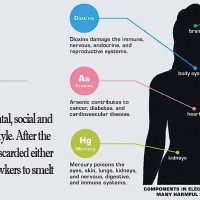- Thursday, 1 January 2026
Climate Change: A Global Emergency
In 1989, a senior UN environmentalist expressed if the trend of global warming is not reversed by the year 2000, then nations will be digging their graves. Fast forward to the year 2022, global warming and climate change are at an alarming rate. Since the 1980s, each decade has been warmer than the previous one. The more leaps humanity makes toward technology, the more hostility towards the planet increases in the same manner. This is why we are hurting the earth more than ever because we now own and use heavy pieces of machinery mercilessly which emit smoke extensively.
Our everyday actions hamper the earth. Something as routine as generating power, riding to work, lighting the bulb, and wasting food causes damage to the environment. When we generate power or electricity, we burn a lot of fossil fuels. Fossil fuels are obtained from decomposed plants and animals. They contain carbon and oxygen which can be burned to produce energy. But producing and burning fossil fuels causes air pollution and many other environmental adversities. They are disastrous for our health and are key in inviting climate change.
Fossil Fuel
Our modern world survives on fossil fuels like; petroleum, natural gas, coal, and so on. Various health issues such as asthma, respiratory disorders, and stroke can arise due to the burning of these fuels. We do not use enough wind, solar, and renewable sources.
The pollution is especially bad in Kathmandu. The dust mixed with warm emissions makes it a disaster. This is why cycling or running are considered high-risk activities here. Such emissions are largely released by vehicles and industries.
The post-pandemic Nepal has seen a great addition of vehicles, especially in the valley. More vehicles equal more pollution. Very few electric vehicles (EVs) are seen in Nepal. Most vehicles are running on oil that emits smoke. Data shows that there are in totality, 1.446 billion cars in the world. The number is outrageous. A typical passenger car emits about 4.6 metric tons of carbon dioxide a year.
And the number of factories amounts to 10 million around the globe. Talking about the US alone, the factories there emit 1.2 trillion gallons of untreated sewage and factorial waste into the water every year and discharge 3 million tons of toxic chemicals. It is estimated that the factories produce roughly 25 percent of the total emissions in the environment. Factories and vehicles are modern gifts to humanity but a curse to our planet. With the motive of making our today better, we are putting our future at grave risk.
This is why world leaders have gathered at the COP27 conference in Egypt. It is the 2022 United Nations climate change conference. The issue of climate change has always seen daylight among people as they keep raising issues about it. Activists and leaders often try to make people take action regarding our planet. Current UN secretary general Antonio Guterres warned the global leaders at the conference saying, “We are on a highway to climate hell with our foot on the accelerator. Our planet is fast approaching tipping points that will make climate chaos irreversible. We need urgent climate action.” Nepal is one of the many countries taking part in the conference where the delegates have planned to put forward the matter regarding; mountains, climate adaptation, agriculture, food security, and emission reductions. These are all burning issues that need to be addressed urgently.
And it seems not all general public has a clear idea about the gravity of climate change. It isn’t just a change in seasonal or wind patterns but plenty of other factors come under it. For example; global warming, drought, frequent and intense weather events, wildfires, physical and mental health impacts, insects outbreak (the recent dengue outbreak is the result of climate change), rise in sea levels and floods, widespread hunger, and many more.
China, the USA, and India are the top three giant nations that emit the most CO2. China alone is responsible for emitting 29.18% of carbon dioxide whereas the US, 14.2%, and India, 7.9%. These numbers add up beyond 50%, so the rest of the world is responsible for the other half of the pollution. It isn’t just about nations. Big companies are also equally responsible for polluting the environment.
A handful of companies around the world, especially multinationals, are responsible for much of plastic waste. Plastics are made by burning fuels and it takes years for them to break down and it stays in the environment for a long time.
Plastics In Animals
Various cases of plastics found in the body of animals have come forward. Once a total of 88 pounds of plastic was found in the stomach of a dead whale in The Philippines. It’s not just whales, but animals like seabirds, sea turtles, seals, and other marine mammals are killed every year after ingesting plastic or getting tangled in it. It is estimated that 56% of the planet’s marine animals like dolphins and whales have consumed plastic, mainly because it can look like a squid or some kind of prey. So, we aren’t just digging our graves but we are also taking animals with us.
At this stage in time, we can only hope and carry some optimism. This crisis is long from over and will only escalate in the coming years. If our ignorance keeps its momentum then the world will be completely unlivable in the coming decades. The rest of the world has to walk in the footsteps of Bhutan, which is a carbon-negative country.
It relies heavily on its renewable hydro energy which the rest of the world has failed to do. And also the forests, which make up to 70% of the total area absorb more carbon dioxide than it produces. Bhutan is the prototype of how the world should look like. Bhutan has shown carbon negativity is a possibility, and that is why people are still out there fighting with the hope to make our planet livable.
(Ghimire pursues higher education and freelance writer)

















